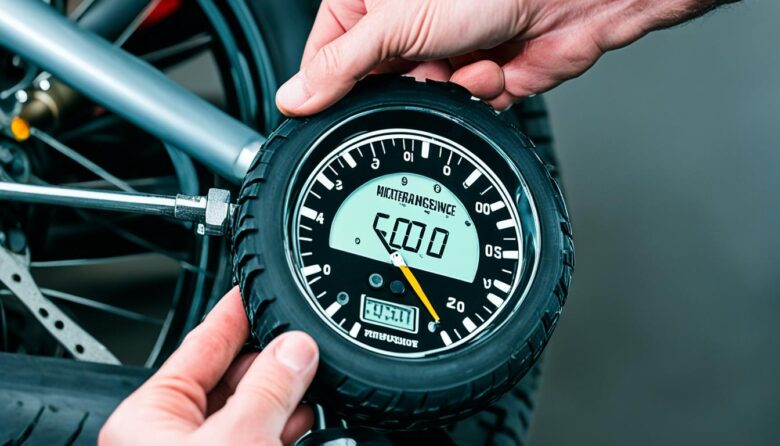Motorcycle tire maintenance plays a crucial role in ensuring optimal performance and safety on the road. Regularly checking tire pressure and tread wear is essential to prevent adverse handling and potential tire failure. Neglecting tire maintenance can increase the risk of accidents and compromise rider safety.
In this article, we will explore the importance of checking tire pressure, how often motorcycle riders should perform these checks, signs of tire wear and when to replace tires, matching and sizing of motorcycle tires, tire safety while riding, common tire pressure myths and best practices, understanding tire wear bars, and the overall significance of proper tire maintenance.
Follow along to learn valuable motorcycle safety tips and discover how you can enhance your riding experience through effective tire care.
Importance of checking tire pressure
Maintaining the correct tire pressure is vital for motorcycle safety. It is recommended to consult the motorcycle manufacturer’s inflation guidelines to determine the appropriate PSI (pounds per square inch) for your tires. This information can typically be found in the owner’s manual or on the bike itself. Checking tire pressure regularly using an accurate tire gauge helps prevent adverse handling, such as wobbling or weaving, and reduces the risk of tire failure.
Proper tire pressure ensures optimal traction, stability, and maneuverability on the road. Underinflated tires can lead to decreased handling, reduced fuel efficiency, and increased tire wear. On the other hand, overinflated tires can result in a harsh ride and decreased contact with the road surface, leading to poor grip and handling.
To check your motorcycle’s tire pressure, follow these steps:
- Ensure your tires are cold, as heat can affect tire pressure readings.
- Locate the valve stem on each tire.
- Remove the valve cap.
- Press the tire gauge firmly onto the valve stem and hold it in place until the gauge provides a reading.
- Compare the reading to the manufacturer’s recommended PSI for your motorcycle.
If the tire pressure is below the recommended level, use an air compressor or visit a gas station with an air pump to add air until the desired pressure is reached. If the pressure is above the recommended level, use the tire gauge to release some air until the correct pressure is achieved.
Remember to check the tire pressure of both the front and rear tires regularly to ensure balanced handling. Don’t forget to replace the valve cap after checking the pressure to prevent debris and moisture from entering the valve stem.
Checking your motorcycle’s tire pressure is a simple yet crucial task that should be incorporated into your regular bike maintenance routine. By maintaining the correct tire pressure, you can enhance your riding experience, improve fuel efficiency, and, most importantly, ensure your safety on the road.
Frequency of tire pressure checks
Proper tire pressure is crucial for motorcycle safety and performance. While motorcycle tire manufacturers generally recommend checking tire pressure at least once a week, many safety experts suggest checking it before every ride. Motorcycles place more demand on tires compared to cars, making frequent pressure checks crucial for optimal performance.
By checking tire pressure regularly, riders can ensure safe and smooth rides. Adjusting the tire pressure as necessary based on the recommended PSI (pounds per square inch) helps maintain optimal handling and traction. This is particularly important as variations in temperature can affect tire pressure.
Regularly inspecting and adjusting tire pressure not only enhances safety but also improves fuel efficiency and prolongs tire life. It allows riders to detect and address any issues promptly, preventing potential tire failure and accidents on the road.
Remember, maintaining the correct tire pressure is an essential part of motorcycle tire care. By following this practice, riders can enjoy a comfortable and safe riding experience.
Importance of Proper Tire Inflation
Proper tire inflation plays a significant role in motorcycle safety. When a tire is underinflated, it can compromise handling, stability, and braking performance. On the other hand, overinflated tires can result in reduced contact with the road, reducing traction and increasing the risk of skidding. Hence, it is crucial to maintain the recommended tire pressure for optimal safety and performance.
Signs of tire wear and when to replace them
Regularly inspecting your motorcycle tires for signs of wear is essential for maintaining safety on the road. By keeping an eye out for these indicators, you can ensure optimal tire performance and minimize the risk of accidents. Here are some common signs of tire wear that you should be aware of:
- Sidewall and Tread Groove Cracking: Check for cracks on the sidewall and between the tread grooves. These cracks can weaken the tire and make it more susceptible to failure, especially during high-speed rides.
- Punctures: Look for any objects embedded in the tire, such as nails or screws. Even a small puncture can lead to a slow leak, compromising tire pressure and overall safety.
- Blisters: Blisters appear as bulges on the tire’s surface and are typically caused by structural damage. These weaken the tire’s integrity and increase the risk of a blowout.
- Knots: Knots are deformities on the tire caused by internal damage. They can lead to severe balance issues and affect overall handling and control.
- Cuts: Check for deep cuts or gashes on the tire. These can expose the underlying layers and compromise the tire’s structural integrity.
- Excessive and Irregular Wear: Uneven tread wear patterns indicate alignment or suspension issues. Excessive wear in certain areas can reduce traction and compromise braking efficiency.
Even if your tires still have sufficient tread depth, it is advisable to replace them if any of these signs of aging are present. Dry rot or cracking is a clear indication that the tire’s rubber has deteriorated. Remember, maintaining optimal tire condition is crucial for your safety on the road.
How to Check Tire Tread Depth
One way to monitor tread wear is by measuring the tread depth. To do this, you can use a penny or a specialized tire tread depth gauge. Insert the penny into the tread groove with Lincoln’s head facing downward. If you can see the top of Lincoln’s head, it’s time to replace the tire. Alternatively, you can use a tread depth gauge to measure the remaining tread depth in millimeters.
Remember, keeping an eye on your tire’s wear and promptly replacing them when necessary will help you maintain optimal safety on the road.
Matching and sizing of motorcycle tires
When it comes to replacing motorcycle tires, ensuring a matching set is essential for optimal performance. The front and rear tires should have complementary tread patterns, whether they are radial or bias ply. Ideally, choosing tires of the same make and model is recommended for consistent handling and performance.
Furthermore, selecting tires that are the same size as the motorcycle’s original equipment tires is crucial. This helps maintain proper handling and ensures that the bike functions as intended by the manufacturer. Incorrect tire sizing can affect the bike’s stability, cornering ability, and overall performance.
By ensuring a matching set of tires with the appropriate size and tread pattern, motorcycle riders can maximize their safety and enjoyment on the road.
Importance of Proper Tire Sizing
Choosing tires that are correctly sized for your motorcycle is not just about aesthetics; it directly impacts the bike’s performance and safety. Oversized or undersized tires can lead to issues such as reduced traction, compromised handling, and potential damage to the bike’s suspension components.
On the other hand, correctly sized tires ensure optimal contact with the road surface, offering the desired grip and stability. This enhances the bike’s maneuverability, responsiveness, and overall control, delivering a safer riding experience.
Consulting the motorcycle’s owner’s manual or speaking with a trusted tire professional can provide specific recommendations regarding the appropriate tire size for your bike. It is important to adhere to these guidelines to maintain the bike’s handling characteristics and safety.
Tire safety while riding
To enhance safety on the road, motorcyclists should be mindful of certain tire safety tips. By following these guidelines, riders can minimize the risk of accidents and maintain optimal tire performance.
Firstly, it is important for motorcyclists to avoid riding on the shoulder or near medians where sharp objects and debris may accumulate. These hazards can puncture tires and cause sudden deflation, compromising control and safety.
Secondly, constant monitoring of tire performance during rides is essential. Motorcyclists should pay attention to any changes in handling, such as increased vibrations or difficulty maintaining balance, as these could indicate problems with tire pressure or tire condition.
Carrying a cell phone while riding is also advised. In case of emergencies, such as a tire blowout or other mechanical issues, having a phone allows motorcyclists to quickly seek assistance and ensure their safety.
Awareness and proactive measures are key to maintaining tire safety while riding. By following these motorcycle safety tips, riders can enjoy their journeys with confidence and peace of mind.
Tire pressure myths and best practices
When it comes to motorcycle tire maintenance and safety, there are several myths and misconceptions that riders should be aware of. It’s crucial to rely on the tire pressure recommended by the motorcycle manufacturer rather than the numbers found on the tire sidewall. The numbers on the sidewall represent the maximum load the tire can handle and may not be suitable for your specific bike.
To ensure optimal handling and performance, it’s important to use an accurate tire gauge to check your tire pressure regularly. By doing so, you can prevent issues such as decreased handling, poor fuel economy, and uneven tire wear caused by underinflation. Topping off tire pressure when necessary helps maintain the recommended levels and enhances motorcycle safety.
When checking tire pressure, it’s advisable to use a personal gauge at home rather than relying on gas station gauges. Gas station gauges can be inaccurate, leading to inconsistent tire pressure readings. By using a personal gauge, riders can have more confidence in the accuracy of their tire pressure measurements, promoting safer rides on the road.
Stay tuned for Section 8, where we’ll discuss the importance of understanding tire wear bars and how to check them.
Understanding tire wear bars
Tire wear bars play a crucial role in motorcycle tire care and safety. These bars are located on the tread of the tire and provide riders with a visual indication of tire wear. As the tire gets worn down, the wear bars become more visible, signaling that it may be time to replace the tire.
Many tire manufacturers include arrows pointing to the wear bars on the sidewall of the tire, making them easier to locate during inspections. Checking the wear bars regularly during tire inspections is essential to assess tire wear and identify any uneven wear patterns that may indicate balance issues.
Proper tire maintenance
Proper motorcycle tire maintenance involves not only checking tire pressure and tread wear but also paying attention to tire wear bars. By monitoring the wear bars during regular inspections, riders can ensure that their tires are in optimal condition and replace them when necessary to maintain safe and reliable performance on the road.
Conclusion
Proper motorcycle tire care is crucial for maintaining safety and performance on the road. By regularly checking tire pressure and tread wear, following manufacturer recommendations, and replacing tires when necessary, riders can ensure optimal handling, traction, and overall safety. Making tire care a priority in your regular maintenance routine is essential to prevent accidents and enhance your riding experience.
Remember that maintaining the correct tire pressure is vital for motorcycle safety. Regularly consult the manufacturer’s inflation guidelines to determine the appropriate PSI for your tires. Use a reliable tire pressure gauge to check the pressure before every ride, as motorcycles put more demand on tires compared to cars.
In addition to tire pressure, monitoring tire tread wear is equally important. Inspect your tires regularly for signs of cracking, punctures, blisters, or excessive and irregular wear. Replace aging tires, even if they still have sufficient tread, to maintain optimal safety on the road. Matching and sizing your motorcycle tires properly is also crucial for optimal performance.
Remember, safe riding starts with proper tire maintenance. By prioritizing motorcycle tire care, you can minimize risks, enhance handling, and enjoy a smoother and safer ride.



